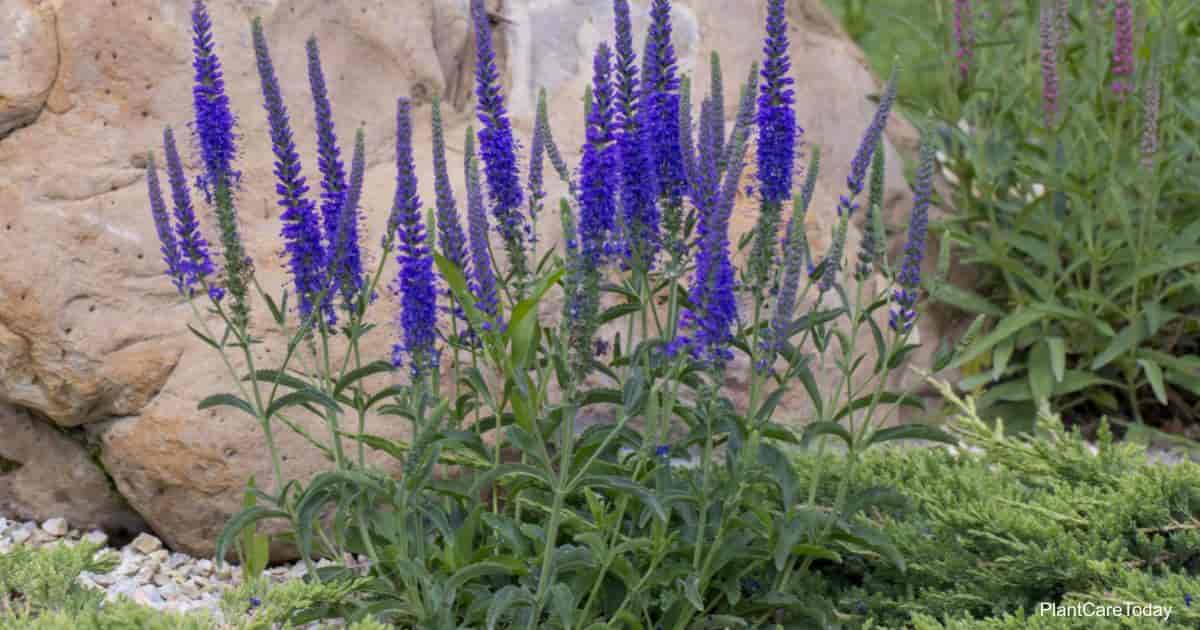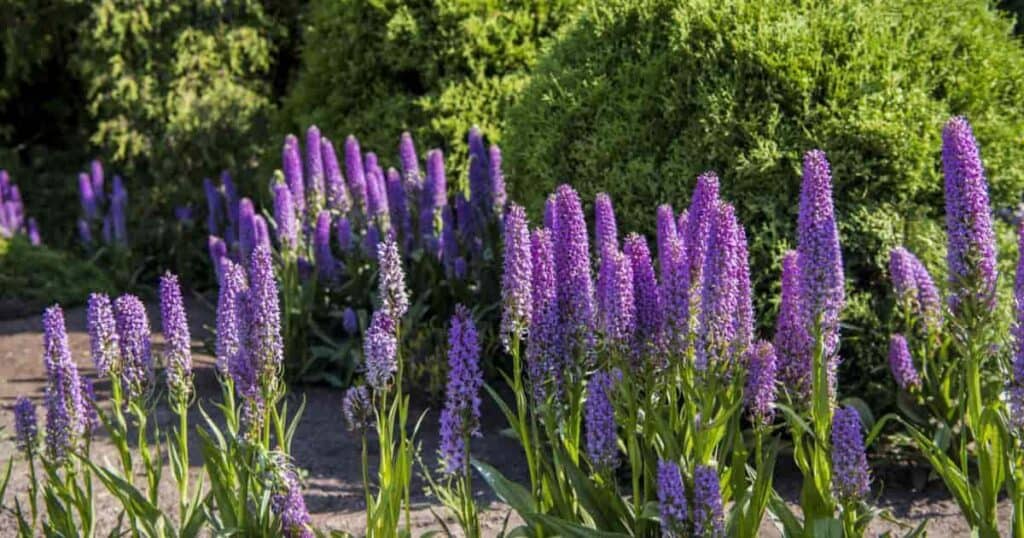The conical flower spikes of the Pride of Madeira (Echium candicans) are something straight of a fairy tale.
It’s easy to imagine the subshrubs planted in a magical garden where creatures reside.

This is how the Echium plant has gained popularity among gardening enthusiasts.
In reality, the botanical name of the plant is Echium candicans. Synonymously known as Echium fastuosum, these plants come from the forget-me-not or borage family, Boraginaceae.
This evergreen shrub or perennial plant species is a member of the Boraginaceae and native to the island of Madeira in Portugal, north of the Canary Islands.
This is where the common name Pride of Madeira comes from.
The specific epithet candicans comes from Latin and means “shining white.” This refers to one of the species forms with white flower color.
Echium Candicans Quick Care Tips
- Botanical Name: Echium candicans
- Common Name(s): Pride of Madeira
- Synonyms: Echium fastuosum, Echium fatuosum
- Pronunciation: EK-ee-um, KAN-dee-kans
- Family & Origin: Boraginaceae family, native to Madeira and the Canary Islands
- Growability: Easy to grow
- Grow Zone: USDA zones 9-10
- Size: Can grow up to 5’ to 6’ feet tall and 6’ to 10’ feet wide
- Flowering: Blooms in late spring with spikes of blue-purple flowers
- Light: Full sun to partial shade
- Humidity: Tolerates dry to medium moisture
- Temperature: Can tolerate temperatures down to 20° to 25°F
- Soil: Fast-draining, moderately-fertile soil
- Water: Drought tolerant but prefers regular watering during the growing season
- Fertilizer: Doesn’t need fertilizer
- Pests & Diseases: Can be susceptible to spider mites, whiteflies, slugs, and root rot
- Propagation: Propagate from seeds or stem cuttings
- Plant Uses: Great for adding color to a garden or as a focal point in a landscape design. Can also be used in coastal gardens due to its salt tolerance.
Echium Candicans: Pride Of Madeira Plant Care
Size and Growth
When all the growing conditions are right, the plant grows up to 5’ to 6’ feet tall and spreads 6’ to 10’ feet.
In the first year, it grows a rosette of leaves. In the subsequent years, almost woody flowering stalks grow tall.

The silvery-green foliage color and narrow, hairy leaves are spectacular when eye-catching flower clusters sit atop in the bloom season.
Flower Color and Fragrance
The flowers on Pride of Madeira are the reason why people love them.
As the bloom time arrives in late spring, the plants produce an abundance of showy spikes covered in purple flowers.

Each conical flower cluster is covered with purple or white flowers with red stamens.
These flowers are not fragrant but full of nectar.
This is why the plants are often revisited by hummingbirds, bees, and butterflies.
Light and Temperature
The plants are hardy to USDA Hardiness Zones 9 through 10, performing their best under full sun, partial shade, and poor soils. It also tolerates dry to medium moisture.

They are short-lived plants and can tolerate temperatures ranging from 20° to 25° degrees Fahrenheit. However, die back when the temperature starts dipping low more than that.
Watering and Feeding
Similar to succulents, the Echium plant has low water needs. This makes them perfect for water-wise gardeners in areas where seasonal drought is common.
Give little water during the summer to provide some hydration.

Never overwater these plants, as it may harm them.
As for fertilization, it is not really required for these herbaceous flowering plants.
Soil & Transplanting Echium Fastuosum

These plants are ornamentally gorgeous and drought tolerant, deer resistant, and hardy to salty winds as they are native to Mediterranean climates.
- Grow them in poor or dry soils with a little bit of water, and they’ll still grow lush.
- For optimal growth, use fast-draining, moderately-fertile soil.
- The plants may be transplanted. Whether you’re moving seedlings or root cuttings, make sure you space them 12” to 15” inches apart.
- Be very careful when transplanting seedlings.
- Instead of directly placing them under the full sun, move them under partial shade.
- Increase sun exposure gradually until they can stand 6 hours of sunlight without wilting.
Grooming and Maintenance

These plants are low-maintenance.
Without any pruning or deadheading, they grow beautiful inflorescences and lush foliage.
However, if you have limited space, prune it back after it has flowered.
Besides giving it a neat look, cuttings will also promote new growth.
How To Propagate Pride of Madeira Plant
These plants grow from seeds or semi-ripe root cuttings in the summer.
When propagating with seeds, make sure you sow the seeds at a depth of 1/8th of an inch.
Start the seeds indoors in the fall, eight weeks before the last frost, and then transplant them outside the nest spring after the last frost has passed.

Use peat pots and put them on propagation mats in an unshaded location.
The seeds should germinate and sprout within one to two weeks.
Remove the heating coil after 3 weeks and water when the soil dries.
Propagation might not be necessary as the plants are fast-growing and reseed freely.
Pride of Madeira Problems: Pests and Diseases
These plants are generally free of most diseases and pest issues. They are even deer resistant.

In some plants, there may be some susceptibility to spider mites, whiteflies, and slugs.
Fortunately, this is prevented and treated with proper care.
Is This Plant Toxic?
Dermal interaction with the foliage may cause skin irritation.
If any part of the plant is ingested in large quantities, it can cause severe digestive discomfort.
Be wary if you have young children and pets around.
Is Echium Invasive?
It is removed from native plant regions and moved to other locations for habitat restoration.
While it’s popular in California, the plant is an invasive species in the region.
It is also considered invasive in Australia and New Zealand.
Echium Candicans Plant Uses
In coastal California, these plants have gained much popularity as ornamental plants for coastal planting. They are drought-tolerant and deer resistant.
Whether you live in San Diego, Sacramento, or another USDA zone, this plant is great for both flower beds and as foundation shrubs.
Since they grow fast, use them to plug gaps in your garden.

Pair with plants such as Bougainvillea, English roses, or Salvia mycrophilia for a stunning landscape look.
As one would imagine looking at the beautiful flowers, this plant benefits various pollinators, including bees, hummingbirds, and butterflies.
The white or purple flowers are full of nectar, providing them nutrition and your garden better pollination.